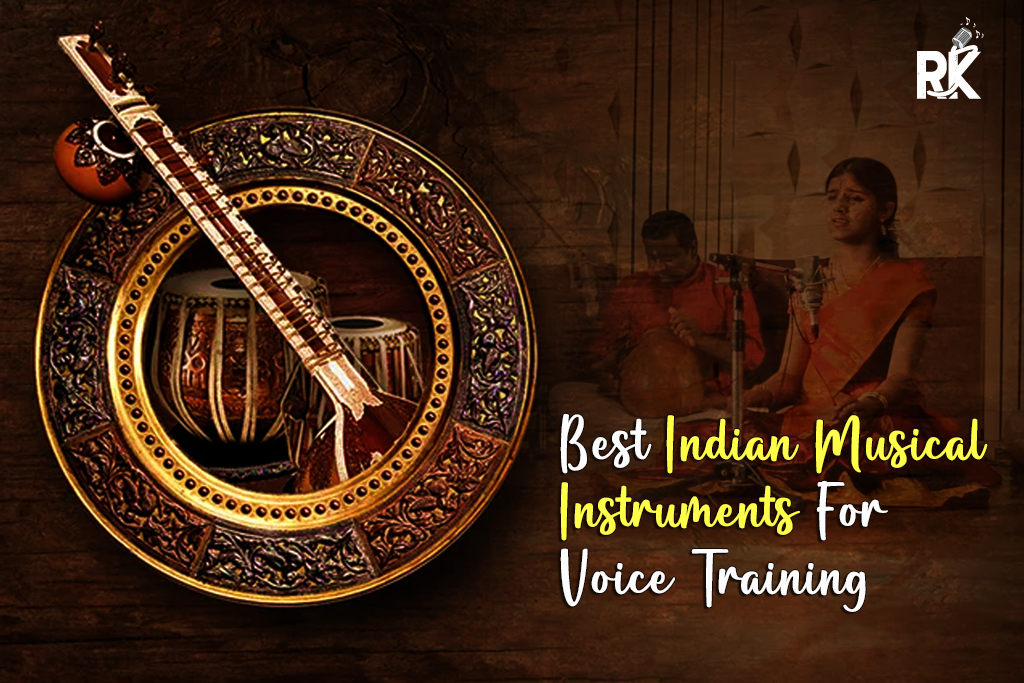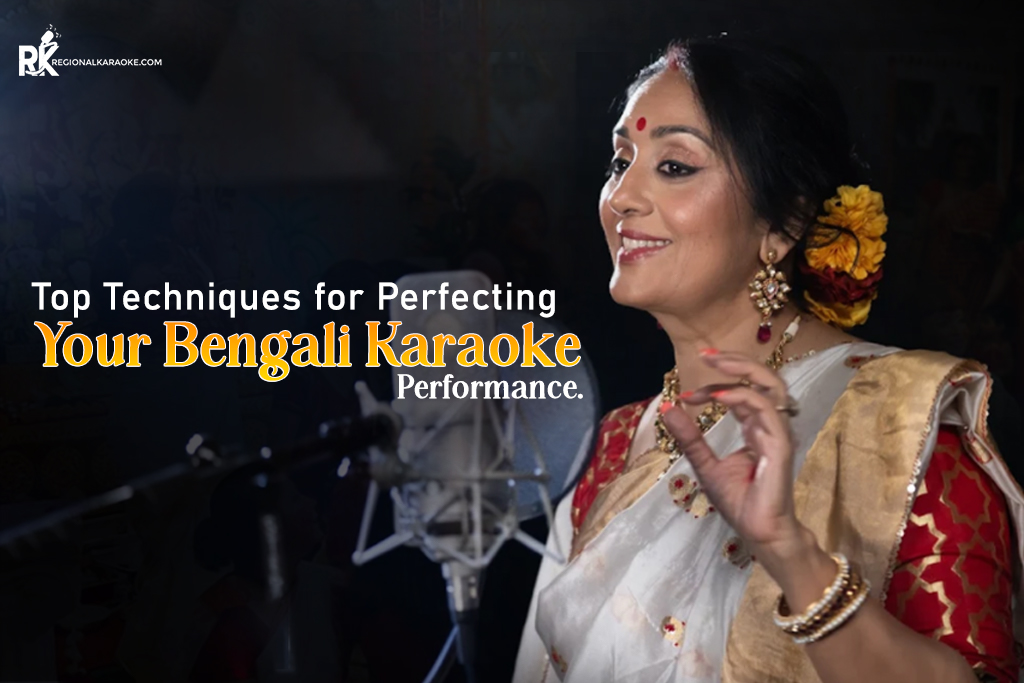Navaratri Store-Wide Karaoke Sale | 30% Off | USE COUPON CODE - NAVRATRI30

- History:
- Present:
- Classical Instruments:
- Folk Instruments:
- Modern Adaptations:
- Musical Instruments for Vocal Production:
- Vocal Techniques and Control:
- Identification and Classification:
- Role in Musical Composition:
- Challenges and Training:
- Two of the most trusted Indian instruments - Tanpura and Harmonium
- 1. Tanpura:
- 2. Harmonium:
- Trust and Significance:
- Electronic and Digital Instruments
- Musical Instruments in Karaoke
- How Does Karaoke Enhance Voice Training?
- Conclusion:
Indian musical instruments represent various traditional and classical instruments that have evolved over centuries, playing a pivotal role in India's rich cultural heritage. These instruments vary widely in their construction, sound production, and usage, showcasing the depth and complexity of Indian music.
Classical singers often use instruments with their singing for more than just making the music sound better. These instruments have particular jobs besides adding to the overall performance. In Indian classical music, there are different instruments, and some are good for training singers, while others are better for live shows.
People have different opinions on which instrument is best for Indian classical singers. Here, we're trying to figure out the different instruments that singers can use, how they help with training, and which are suitable for live performances.
Let's explore the history of the best instrument for Indian classical singers.
History:
The history of Indian musical instruments dates back thousands of years and is deeply rooted in ancient texts and scriptures. The Natya Shastra, an ancient Sanskrit text on performing arts, mentions various instruments and their classifications. Instruments like the veena, mridangam, flute, and various drums are mentioned in these texts, emphasizing their existence in ancient Indian music.
Over time, Indian music evolved through various periods, each contributing to the development and refinement of musical instruments. Influences from different regions and dynasties led to the emergence of distinct styles and instruments across India. The Mughal era, for instance, brought in Persian and Central Asian influences, contributing to the evolution of instruments like the sitar and tabla.
Present:
In the contemporary era, Indian musical instruments hold immense significance in classical and folk traditions. They play an integral role in classical music, devotional, folk, and contemporary genres.
Classical Instruments:
- Sitar: Known for its resonant strings and intricate fretwork, the sitar is iconic in Hindustani classical music.
- Tabla: A pair of drums used in Hindustani and Carnatic classical music, revered for their complex rhythms.
- Flute: The bamboo flute, often associated with Lord Krishna, is a crucial instrument in classical and devotional music.
- Veena: A stringed instrument with a rich history, prominent in Carnatic music, with variations like the Saraswati veena and Rudra veena.
- Tanpura: Known for its drone-like sound, it accompanies vocalists and provides a reference pitch in classical performances.
Folk Instruments:
- Dholak: A double-headed drum widely used in folk music and celebratory occasions.
- Ektara: A single-stringed instrument used in folk music, particularly by wandering minstrels.
- Pungi: Also known as the snake charmer's flute, snake charmers traditionally use it, but it is also seen in folk performances.
Modern Adaptations:
- Electric Sitar: A contemporary adaptation of the traditional sitar, incorporating electronic amplification.
- Electric Tabla: An electronic version of the tabla that allows for varied sounds and volume control.
Despite modern innovations, the essence of traditional Indian instruments remains intact, reflecting the country's musical heritage. These instruments continue to be passed down through generations, preserving their cultural significance and contributing to the vibrant music of India. Additionally, efforts are being made to integrate these instruments into global music, showcasing their versatility and adaptability beyond Indian shores.
Musical Instruments for Vocal Production:
The human voice is produced through a complex interplay of various anatomical components. The primary organs involved include the lungs, diaphragm, larynx, vocal cords, and resonating cavities (pharynx, mouth, and nasal passages). Air from the lungs passes through the vocal cords, causing them to vibrate. The pitch, tone, and quality of the voice influence the tension of the vocal cords and the shape of the resonating cavities.
Vocal Techniques and Control:
Vocalists employ various techniques to manipulate their voices for musical expression. Techniques such as breath control, pitch modulation, vibrato, articulation, and resonance management are fundamental for singers to convey emotions, dynamics, and nuances within a piece of music. These techniques require dedicated practice to develop control and precision.
Identification and Classification:
The human voice is categorized into different registers and types in musical compositions. Vocal registers include chest voice, head voice, and falsetto (in male voices), each contributing distinct tonal qualities. Vocal classifications encompass soprano, alto, tenor, and bass (in classical music), determining the range and tessitura of a singer's voice.
Role in Musical Composition:
The voice is a versatile instrument capable of conveying many emotions and narratives. It is prominent in various musical genres, including classical, opera, pop, rock, jazz, and traditional folk music. Composers and songwriters utilize the voice to deliver melodies, lyrics, harmonies, and vocalizations that shape the overall musical composition.
Challenges and Training:
Mastering the voice as an instrument requires dedicated training, consistent practice, and proper vocal care. Vocalists face challenges such as vocal fatigue, pitch accuracy, breath control, and maintaining vocal health. Professional vocal training involves exercises to strengthen the voice, expand vocal range, and refine techniques to achieve optimal performance.
Understanding the human voice as a musical instrument involves a multifaceted exploration of its anatomy, techniques, classifications, and integral role in musical expression. The intricate nature of the voice as an instrument continues to captivate audiences worldwide, showcasing its unparalleled ability to convey emotions and tell stories through the power of music.
Two of the most trusted Indian instruments - Tanpura and Harmonium
Tanpura and Harmonium are integral Indian musical instruments for vocalists, each playing a significant role in vocal training and performances.
1. Tanpura:
The Tanpura holds a revered position in Indian classical music. It is the quintessential drone instrument, providing a continuous harmonic resonance as a reference pitch for vocalists.
Key reasons why vocalists trust it include:
Pitch Maintenance: Its sustained, continuous sound helps singers maintain the correct pitch while performing or practicing, fostering a sense of war (musical notes) and their tonal nuances.
Understanding Ragas: The Tanpura aids singers in comprehending and internalizing the intricacies of ragas, guiding them through the melodic structures and helping them grasp the emotional essence of each raga.
Tonal Support: Its harmonic backdrop offers tonal support, allowing vocalists to modulate their voices and confidently explore the depths of various octaves.
2. Harmonium:
The Harmonium, though not traditionally an Indian instrument (having roots in European reed organs), has become an integral part of Indian music, especially in vocal training and accompaniment. Its popularity among vocalists is due to the following:
Versatility: The Harmonium's keyboard layout allows singers to practice different musical scales, aiding in understanding swarasthana (positions of notes) and facilitating easy modulation during singing practice.
Breath Control and Sustained Notes: By playing the Harmonium, vocalists learn breath control techniques and the art of sustaining notes, which are essential for seamless vocal performances.
Accompaniment and Composition: Vocalists often use it for accompaniment during practice sessions and performances, providing harmonic support and aiding in composing new melodies and songs.
Trust and Significance:
Tanpura and Harmonium are trusted to provide consistent pitch references and harmonic support. They assist in technical aspects such as maintaining pitch accuracy and understanding musical structures and contribute to the emotional and expressive facets of a vocalist's performance.
Their presence is integral during vocal training sessions, where the Tanpura's resonant tones and the Harmonium's harmonic backing serve as guiding forces for vocalists, nurturing their skills and fostering a deeper understanding of the intricacies of Indian classical music. As such, their trustworthiness and significance in aiding vocalists in their musical journey remain unparalleled.
Electronic and Digital Instruments
Electronic and digital instruments have revolutionized music creation, expanding the sonic palette available to musicians across various genres. These instruments rely on electronic or digital mechanisms to produce, modify, and amplify sounds, offering versatility and innovation in musical expression.
Synthesizers: Among the most iconic electronic instruments, synthesizers generate sounds through oscillators, filters, and modulators. They're versatile, producing a broad spectrum of tones—from classic analog warmth to futuristic digital textures—allowing musicians to sculpt and design unique sounds.
Digital Keyboards: These instruments, including electric pianos and MIDI controllers, replicate acoustic counterparts using digital technology. They offer touch-sensitive keys, pre-programmed sounds, and connectivity options, serving as staples in live performances and studio recordings.
Drum Machines: Crucial in electronic music genres, drum machines create rhythmic patterns and beats through programmed sequences or sampled sounds. They allow musicians to craft intricate percussive arrangements and are fundamental in hip-hop, dance, and electronic music production.
Digital Audio Workstations (DAWs): While not traditional instruments, DAWs are software platforms for recording, editing, and producing music. They offer various tools, effects, and virtual instruments, allowing musicians to compose, arrange, mix, and master music entirely within a computer environment.
Samplers: These instruments record and playback audio samples, enabling musicians to manipulate and layer sounds creatively. They're pivotal in creating unique sonic textures by blending and modifying recorded snippets.
MIDI Instruments: MIDI technology facilitates communication between instruments and computers. MIDI instruments produce digital signals that trigger sounds on compatible devices, offering flexibility in Music Production, live performances, and controlling various sound modules.
Impact and Evolution: Electronic and digital instruments have significantly influenced modern music, creating entirely new genres and pushing the boundaries of sonic exploration. Their portability, diverse sound capabilities, and adaptability to different musical styles have made them indispensable in contemporary music-making.
Furthermore, these instruments continue to evolve, incorporating advanced technologies such as AI, touch-sensitive interfaces, and cloud connectivity. As a result, they empower musicians with limitless possibilities for creativity and innovation, reshaping the musical across genres and appealing to artists and audiences worldwide.
Musical Instruments in Karaoke
Karaoke, a popular form of entertainment where people sing along to instrumental song tracks, relies on various musical instruments to create the backing tracks for singers. These backing tracks are carefully crafted to mimic the original song, allowing individuals to enjoy a fun and interactive singing experience. Several musical instruments play a significant role in producing these karaoke tracks:
1. Keyboard/Synthesizer: Keyboards or synthesizers are central in creating karaoke tracks. They provide various sounds, including piano, strings, brass, and other instrument tones. These instruments generate the songs' melodies, harmonies, and instrumental sections.
2. Drum Machine or Drum Sampler: Percussion tracks provide rhythm and groove to karaoke songs. Drum machines or drum samplers replicate various drum sounds and rhythms, ensuring the right beat and tempo for singers to follow.
3. Guitar/Bass Guitar: These instruments add depth and texture to karaoke tracks, especially in genres like rock, pop, or country. Guitar tracks replicate both rhythm and lead sections, while bass guitars provide the foundation by complementing the rhythm with low-end frequencies.
4. Virtual Instruments/Sound Modules: Karaoke tracks often utilize virtual instruments or sound modules, digital representations of real instruments. These modules offer various instrument sounds and effects, allowing flexibility in creating diverse musical arrangements.
5. Audio Effects Processors: Effects processors play a vital role in enhancing the overall sound quality of karaoke tracks. They add reverbs, echoes, chorus effects, and other audio enhancements to simulate the atmosphere of a live performance.
6. MIDI Controllers and Sequencers: These devices allow music producers to control and sequence various musical elements in karaoke tracks. They enable precise arrangement, timing, and layering of different instrument tracks to replicate the original song structure.
7. Mixing Consoles and Software: Mixing consoles or software platforms balance and blend different instrument tracks, vocals, and effects. They ensure the final karaoke track achieves a balanced sound suitable for singing along.
Creating karaoke tracks involves combining instrumental elements and technology to replicate popular songs accurately. These instruments and tools work together to provide a comprehensive and enjoyable musical backdrop for karaoke enthusiasts to sing along and have a great time.
How Does Karaoke Enhance Voice Training?
Karaoke can significantly elevate voice training, especially when exploring Indian musical traditions alongside specific instruments. Here's how karaoke contributes to vocal development in alignment with the context of Indian musical instruments:
Pitch Precision: Karaoke is a powerful tool for honing pitch accuracy, aligning perfectly with the intricate scales and tonal variations of Indian music, which are emphasized in instruments like the tanpura or harmonium.
Rhythmic Mastery: Indian music is known for its complex rhythmic patterns, and karaoke allows singers to practice maintaining tempo and rhythm, aligning with instruments like the tabla that emphasize rhythm intricacies.
Melodic Understanding: By singing along with karaoke tracks, vocalists can deepen their understanding of melody and scale, which resonates with the melodic capabilities emphasized in instruments like the swarmandal.
Expression and Emotion: Karaoke encourages singers to convey emotion and expression, an essential aspect of Indian musical training that resonates with the vibrant quality of instruments like the sitar or sarangi.
Cultural Immersion: Engaging with regional karaoke widens cultural exposure, aligning beautifully with the diversity of Indian musical instruments and their regional variations.
For an enriched vocal training experience steeped in Indian musical traditions, you can check out the Regional Karaoke website, where you'll find many Indian songs in different languages and styles. It's all about Indian music, and it's pretty cool because you can practice singing in different ways. It's a neat way to learn more about Indian music while honing your singing skills.
Conclusion:
In Indian classical music, some instruments are helpful for singers to practice and improve their voice. Instruments like the Harmonium, tanpura, and tabla are great for this. Harmonium helps singers understand melody and pitch. It gives a musical background for singers to practice with. Tanpura provides a continuous sound that helps singers maintain the right pitch and tone while practicing. Tabla is good for learning rhythm and timing. It helps singers get a good sense of the beats and rhythms in music. These instruments work together to support singers differently, making it easier for them to develop their singing skills and become better performers.
Tags: Music production, Regional karaoke






